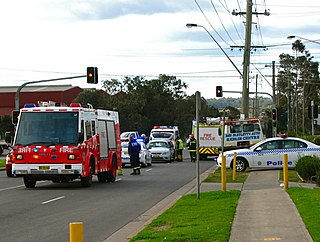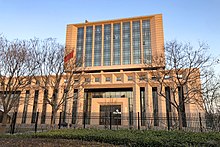
Civil defense or civil protection is an effort to protect the citizens of a state from human-made and natural disasters. It uses the principles of emergency operations: prevention, mitigation, preparation, response, or emergency evacuation and recovery. Programs of this sort were initially discussed at least as early as the 1920s and were implemented in some countries during the 1930s as the threat of war and aerial bombardment grew. Civil-defense structures became widespread after authorities recognised the threats posed by nuclear weapons.

Emergency services and rescue services are organizations that ensure public safety, security, and health by addressing and resolving different emergencies. Some of these agencies exist solely for addressing certain types of emergencies, while others deal with ad hoc emergencies as part of their normal responsibilities. Many of these agencies engage in community awareness and prevention programs to help the public avoid, detect, and report emergencies effectively. Emergency services are often considered first responders, and typically have dedicated emergency vehicles.

Search and rescue (SAR) is the search for and provision of aid to people who are in distress or imminent danger. The general field of search and rescue includes many specialty sub-fields, typically determined by the type of terrain the search is conducted over. These include mountain rescue; ground search and rescue, including the use of search and rescue dogs ; urban search and rescue in cities; combat search and rescue on the battlefield and air-sea rescue over water.

The Ministry of Education of the People's Republic of China is a constituent department of the State Council, responsible for basic education, vocational education, higher education, and other educational affairs throughout the country. The Ministry of Education acts as the predominant funder of national universities and colleges in China. The ministry also accredits tertiary institutions, degree curriculum, and school teachers of the country.
Public Safety Canada, legally incorporated as the Department of Public Safety and Emergency Preparedness (PSEPC), is the department of the Government of Canada responsible for (most) matters of public safety, emergency management, national security, and emergency preparedness in Canada.

Texas A&M Engineering Extension Service is a state extension agency that offers training programs and technical assistance to public safety workers, both in Texas and around the world. Established in 1940 as the Industrial Extension Service, the agency took on its current name when it joined The Texas A&M University System in 1948. The agency sponsors the state's primary urban search and rescue force, Urban Search and Rescue Texas Task Force 1, and operates the Brayton Fire Training Field. Brayton is the largest firefighting training facility in the United States, and also contains a mock city for conducting training operations for emergency responders.

Emergency management or disaster management is a science and a system charged with creating the framework within which communities reduce vulnerability to hazards and cope with disasters. Emergency management, despite its name, does not actually focus on the management of emergencies, which can be understood as minor events with limited impacts and are managed through the day-to-day functions of a community. Instead, emergency management focuses on the management of disasters, which are events that produce more impacts than a community can handle on its own. The management of disasters tends to require some combination of activity from individuals and households, organizations, local, and/or higher levels of government. Although many different terminologies exist globally, the activities of emergency management can be generally categorized into preparedness, response, mitigation, and recovery, although other terms such as disaster risk reduction and prevention are also common. The outcome of emergency management is to prevent disasters and where this is not possible, to reduce their harmful impacts.

The Ministry of Civil Defence, Emergencies and Disaster Relief is a Russian government agency overseeing the civil emergency services in Russia.
The New Zealand Co-ordinated Incident Management System (CIMS) is New Zealand's system for managing the response to an incident involving multiple responding agencies. Its developers based the system on the United States' Incident Command System (ICS) - developed in the 1970s - and on other countries' adaptations of ICS, such as Australia's Australasian Inter-Service Incident Management System (AIIMS).
The Ministry of Emergency Management and Climate Readiness (EMCR), formerly Emergency Management BC (EMBC), is a provincial government department in the Canadian province of British Columbia. EMCR works with local governments and other provincial and federal agencies year round, providing coordination and support before, during and after emergencies. EMCR is administered under the Emergency Program Act.
As firefighting has a rich history throughout the world, traditions in this profession vary widely from country to country.

A FEMA Urban Search and Rescue Task Force is a team of individuals specializing in urban search and rescue, disaster recovery, and emergency triage and medicine. The teams are deployed to emergency and disaster sites within six hours of notification. The Federal Emergency Management Agency (FEMA) created the Task Force concept to provide support for large scale disasters in the United States. FEMA provides financial, technical and training support for the Task Forces as well as creating and verifying the standards of Task Force personnel and equipment.

The fire services in the United Kingdom operate under separate legislative and administrative arrangements in England and Wales, Northern Ireland, and Scotland.
In Ukraine, emergency medical services are provided by the Ukrainian Emergency Medical Services (UEMS), a special type of government rescue service, the main task of which is to provide free of charge medical assistance to victims, rescuers and any other persons who take part in the response to and/or recovery process after incidents of any kind.
The California Governor's Office of Emergency Services is a California cabinet-level office responsible for overseeing and coordinating emergency preparedness, response, recovery and homeland security activities within the state. The agency was created by AB 38 (2008), superseding both the Office of Emergency Services (OES) and Office of Homeland Security (OHS).

Search and rescue in the United States involves a wide range of organizations that have search and rescue responsibilities.

The Disaster and Emergency Management Presidency is a governmental disaster management agency operating under the Turkish Ministry of Interior. The organisation was established in 2009 to take necessary measures for effective emergency management and civil protection nationwide in Turkey. The presidency conducts pre-incident work, such as preparedness, mitigation and risk management, during-incident work such as response, and post-incident work such as recovery and reconstruction. AFAD reports to the Turkish Ministry of Interior.
Many countries around the world have civil defense organizations dedicated to protecting civilians from military attacks and providing rescue services after widespread disasters. In most countries, civil defense is a government-managed and often volunteer-staffed organization.
China International Search and Rescue(CISAR) team was a professional heavy search and rescue team responsible for search and rescue during earthquake breakout, which existed from 2001 to 2018 until it was superseded by the China Search and Rescue team formed by the Ministry of Emergency Management.

National Fire and Rescue Administration (国家消防救援局) is the state emergency service force for firefighting and rescue in China, which is part of the civil service and is administered by the Ministry of Emergency Management (MEM).













